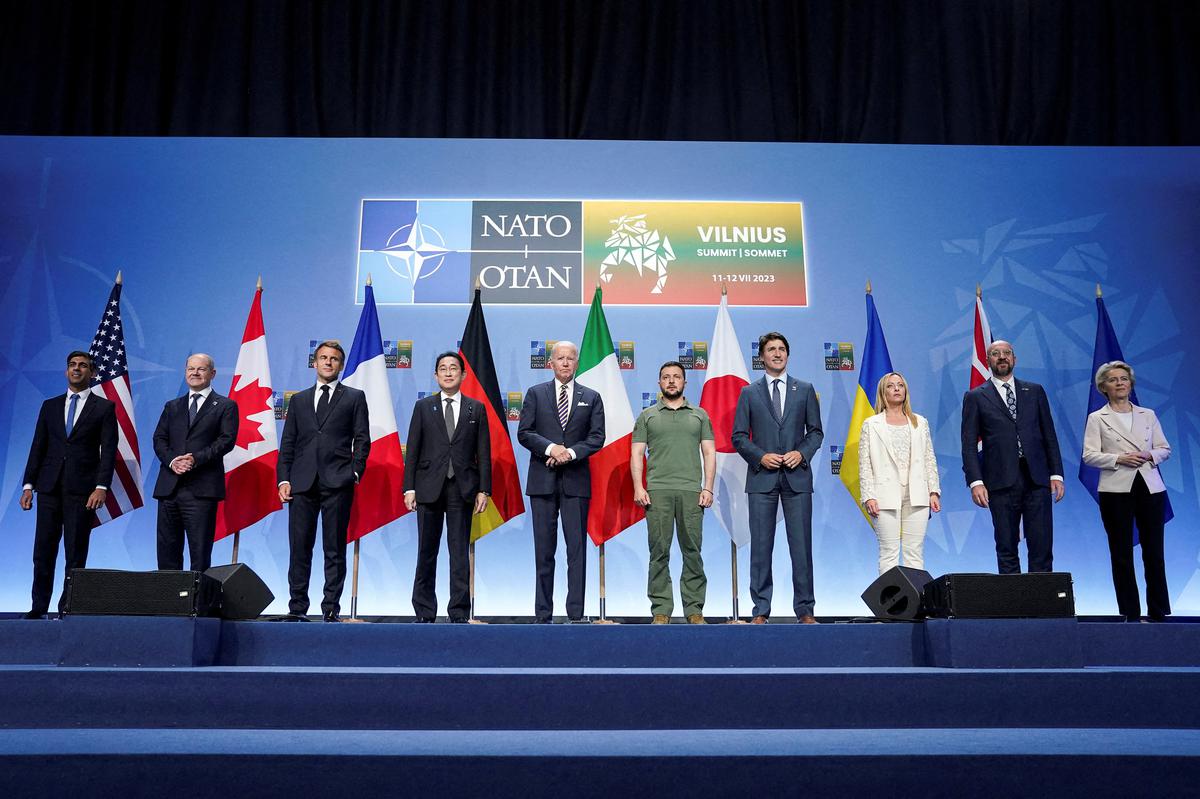In a momentous NATO summit held in Vilnius, Lithuania, the alliance achieved significant growth and unity, highlighting Russia’s strategic failure in its invasion of Ukraine. The summit witnessed one new member joining the table, with two more countries set to follow suit, symbolizing NATO’s robust expansion and resolve in the face of aggression.
Secretary-General Jens Stoltenberg emphasized that Russian President Vladimir Putin’s expectations of deterring NATO’s eastern expansion through military action have entirely backfired. The focus of the summit centered around supporting Ukraine, strengthening national defense spending, and shaping the alliance’s future composition.
NATO’s Expansion and Russia’s Miscalculation:

With Finland successfully meeting the membership requirements in time for the summit, the organization welcomed a new member at the table. Additionally, the applications from Sweden and Ukraine demonstrated Russia’s miscalculation as it pushed these nations to seek NATO membership in response to its invasion of Ukraine.
Turkey’s Shifting Stance:
- Initially, Turkey had blocked Sweden’s bid for NATO membership, citing concerns over the country’s handling of Kurdish militant groups.
- However, a positive shift occurred during the summit as Turkish President Recep Tayyip Erdogan agreed to withdraw his objection.
- Following meetings with Stoltenberg and Swedish Prime Minister Ulf Kristersson, Erdogan committed to presenting Sweden’s ratification to Turkish lawmakers in October.
- This change in stance was deemed a pivotal achievement, with President Biden being credited for facilitating the breakthrough.
Ukraine’s Path to NATO Membership:
- NATO members concurred that Ukraine’s membership could only be pursued once the ongoing conflict ends, as an earlier admission could escalate tensions with Russia and draw the alliance into direct confrontation.
- Ukrainian President Volodymyr Zelenskyy left the summit without a definitive timeline for membership but received pledges for long-term security assistance from the United States and other G-7 nations.
- Secretary-General Stoltenberg acknowledged that the summit had brought Ukraine closer to NATO membership, underscoring the significance of Ukraine’s stability and democracy for any membership consideration.
NATO’s Collective Defense and Countermeasures:
- The summit also addressed NATO’s response to a potential Russian attack on its territory.
- Member countries committed to allocating at least 2% of their national GDP towards defense spending, reinforcing NATO’s readiness and deterrence.
- Moreover, the alliance agreed on countering any aggression effectively, demonstrating its united stance against security threats.
Turkey’s Importance as an Ally:
- Emphasizing Turkey’s crucial role as a NATO ally, Stoltenberg highlighted its vital contribution in the fight against ISIS in Iraq and Syria, given its strategic border location.
- Additionally, the significance of enhanced cooperation with Turkey in combating terrorist organizations like the PKK, which have impacts beyond Turkey’s borders.
Strengthening NATO with Scandinavian Membership:
- The accession of Scandinavian countries, particularly Sweden and Finland, was lauded as a pivotal step in reinforcing NATO’s strength.
- With Finland’s membership, NATO’s border with Russia more than doubled, exemplifying the alliance’s increasing presence in the region and defying Russia’s expectations.
Supporting Ukraine’s Counteroffensive:
- Throughout the summit, the United States demonstrated strong leadership and unwavering support for Ukraine, providing essential aid in terms of ammunition and advanced weapons systems.
- European allies also stepped up by increasing defense spending to record highs and extending their support to Ukraine’s defense efforts.
Key Points on NATO
NATO: North Atlantic Treaty Organization
- Established in 1949 as a military alliance.Primary objective:
- Collective defense and security of member countries.
Core Principles
- Article 5: Attack on one member is an attack on all.
- Promotes democratic values and peace.
Membership and Expansion
- Originally 12 members, now has 31 member countries.
- Expansion has been a source of tension with Russia.
Russia and NATO

- NATO’s eastward expansion concerns Russia.
- Tensions escalated due to the conflict in Ukraine.
Ukraine’s Aspirations
- Interest in joining NATO due to Russia’s aggression.
- Membership consideration after conflict resolution.
Defense Spending
- NATO members commit to 2% of GDP on defense.
- Enhances alliance capabilities and readiness.
Sweden and Finland’s Membership
- Sweden’s bid approved after addressing concerns.
- Finland joined, bolstering NATO’s northern flank.
Turkey’s Role and Importance
- Crucial NATO ally in counter-terrorism efforts.
- Strategic location critical for southeastern defense.
Find More News related to Summits and Conferences



 Indian Olympic Medal Winners List Till N...
Indian Olympic Medal Winners List Till N...
 Who is the Inventor of the Gramophone?
Who is the Inventor of the Gramophone?
 HS Dhaliwal Appointed New DGP Of Andaman...
HS Dhaliwal Appointed New DGP Of Andaman...
